
Jeff Wall 1993
Transparency in lightbox 2290 x 3770 mm
Tate. Purchased with assistance from the Patrons of New Art through
the Tate Gallery Foundation and from the National Art Collections Fund
1995.
Cinematographic photograph
©The
artist
dontinclude virtual="image_table.htm"
This major retrospective of the work of Canadian photographer Jeff Wall
brings together over fifty stunning works produced between the late
1970s and the present day, providing an overview of his entire career.
Wall has exhibited his photographs internationally for the twenty-five
years and is one of the most intriguing and influential artists working
today. He has also played a key role in establishing photography as
a contemporary art form.
Included are iconic works like A Sudden Gust of Wind 1993, Milk 1984 and Tran Dúc Ván 1988–2003, as well as lesser-known photographs which have rarely been exhibited in this country. Developed in close collaboration with the artist, this is the most comprehensive survey of his fascinating career to date, to take place in the UK.
The exhibition was created by Schaulager Basel in collaboration with Tate Modern, London. The London exhibition was curated in collaboration with Jeff Wall by Sheena Wagstaff, Chief Curator, Tate Modern, and Vincent Honoré, Assistant Curator, Tate Modern
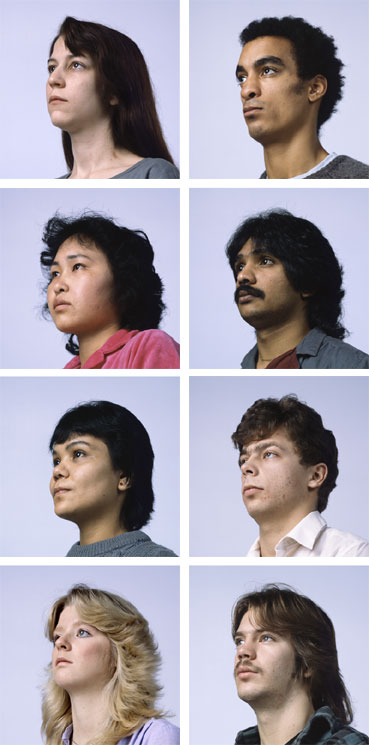
Young Workers 1978/1983
8 transparencies in lightboxes,
each 1015 x 1015 mm
Emanuel Hoffmann Foundation, on permanent loan to the ?ffentliche Kunstsammlung
Basel, ? Jeff Wall
Cinematographic photograph
The
Destroyed Room 1978
'My first pictures like The Destroyed Room emerged from a re-encounter
with nineteenth-century art', Wall has said. Here, the work in question
is The Death of Sardanapalus (1827) by Eugène Delacroix, which depicts
the Assyrian monarch on his deathbed, commanding the destruction of
his possessions and slaughter of his concubines in a last act of defiance
against invading armies.

The Destroyed Room 1978
Transparency in lightbox 1590 x 2340 mm
National Gallery of Canada, Ottawa. Purchased 1988
Cinematographic photograph
©
Jeff Wall
Wall echoes Delacroix's composition, with its central sweeping diagonal
and sumptuous palette of blood reds, while acknowledging its staged
atmosphere by re-composing the scene as a roughly fabricated stage-set,
absent of any players. 'Through the door you can see that it's only
a set held up by supports, that this is not a real space, this is no-one's
house,' he has commented. Though clearly a woman's bedroom, the cause
of the violence is unexplained, leaving the viewer to speculate on the
sequence of events.
Picture for Women 1979
Picture for Women was inspired by Edouard Manet's masterpiece A Bar
at the Folies-Bergères (1881–82). In Manet's painting, a barmaid gazes
out of frame, observed by a shadowy male figure. The whole scene appears
to be reflected in the mirror behind the bar, creating a complex web
of viewpoints. Wall borrows the internal structure of the painting,
and motifs such as the light bulbs that give it spatial depth. The figures
are similarly reflected in a mirror, and the woman has the absorbed
gaze and posture of Manet's barmaid, while the man is the artist himself.
Though issues of the male gaze, particularly the power relationship
between male artist and female model, and the viewer's role as onlooker,
are implicit in Manet's painting, Wall updates the theme by positioning
the camera at the centre of the work, so that it captures the act of
making the image (the scene reflected in the mirror) and, at the same
time, looks straight out at us.
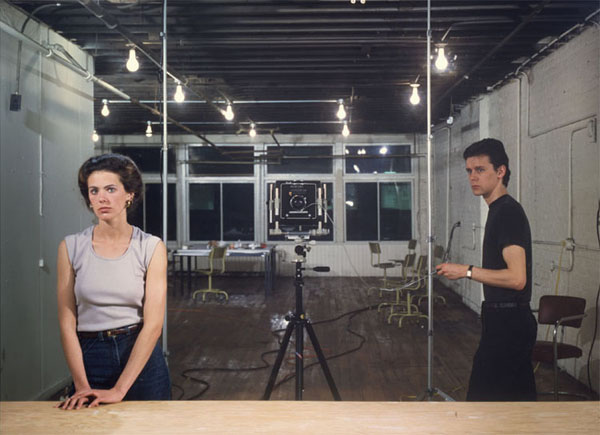
Picture for Women 1979
Transparency in lightbox 1425 x 2045 mm
Collection of the artist. Courtesy Marian Goodman Gallery, New York
Cinematographic photograph
©
Jeff Wall
The seam running down the middle of the photograph is apparent in some
of Wall's large-scale pictures, where two pieces of transparency are
joined. The fact that it serves as a reminder of the artifice of picture
making is something that Wall has come to appreciate: 'The join between
the two pictures brings your eye up to the surface again and creates
a dialectic that I always enjoyed and learned from painting... a dialectic
between depth and flatness. Sometimes I hide it, sometimes I don't',
he has said.

The Bridge 1980
Transparency in lightbox 605 x 2285 mm
Friedrich Christian Flick Collection
Documentary photograph
©
Jeff Wall

The Old Prison 1987
Transparency in lightbox 70 x 2285 mm
Collection J?rg Johnen
Documentary photograph
©
Jeff Wall
Steve’s Farm, Steveston 1980
While the two works in the previous room were carefully staged, here,
in his first documentary photograph, Wall chooses a location he knows
well, on the fringes of his home city of Vancouver. The scale of the
work evokes traditional landscape painting. The familiar device of the
sweeping pathway leading to the horizon enhances this effect, while
the tiny figure on the path underlines the openness of the landscape.
However, the elements that make up the scene – a scattering of suburban
housing, a few farmyard animals and an expanse of bare, scrubby track
– are a far cry from idealised visions of pastoral landscape. Wall often
selects these transitional environments, where urban life meets nature.
'I make landscapes, or cityscapes as the case may be, to study the process
of settlement as well as to work out for myself what the kind of picture
(or photograph) we call "landscape" is', he has explained.

Steves Farm, Steveston 1980
Transparency in lightbox 580 x 2286 mm
Frac Nord–Pas de Calais, Dunkerque, France
Documentary photograph
©
Jeff Wall
Mimic 1982
The large colour-print format that Wall favours requires a camera that
is ill-suited to capturing fleeting moments, yet he wanted to explore
the documentary style of street photography practiced by a number of
photographers, such as Robert Frank or Garry Winogrand. Wall's solution
was to restage such moments, preserving a sense of immediacy by using
non-professional actors in real settings. He calls these constructed
images 'cinematographic photographs'. In Mimic, the white man's 'slant-eyes'
gesture recreates a scene of racial abuse that Wall witnessed on a Vancouver
street.
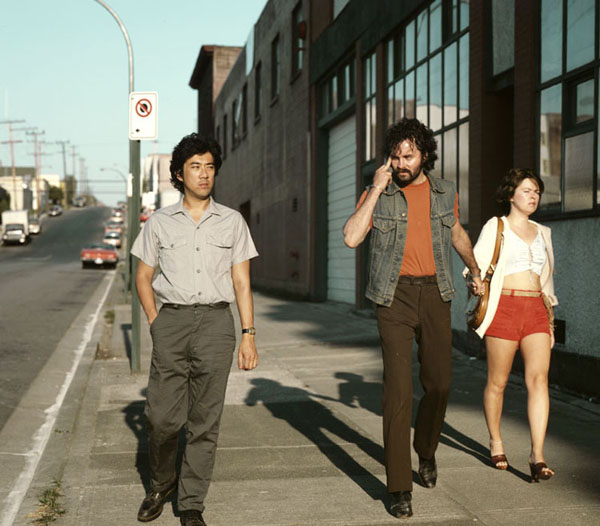
Mimic 1982
Transparency in lightbox 1980 x 2286 mm
Courtesy of the Ydessa Hendeles Art Foundation, Toronto
Cinematographic photograph
©
Jeff Wall
Milk 1984
Milk is another depiction of a socially charged subject. 'Suffering
and dispossession remain at the centre of social experience', Wall has
commented. The explosive burst of liquid is emblematic of the man's
state of mind, but what might have provoked such extreme emotion is
not revealed, a state of ambiguity that ensures the work cannot be understood
as moral commentary. The process of reconstructing an event allows Wall
the freedom to reinvent the composition. He often relocates the action
to a different setting, a place chosen for its formal or pictorial qualities,
as is the case here. The grid-like order of the brick wall background,
and strong vertical bands that stripe the left side of the image contrast
sharply with the tension in the man's arms and the uncontrolled arc
of milk.
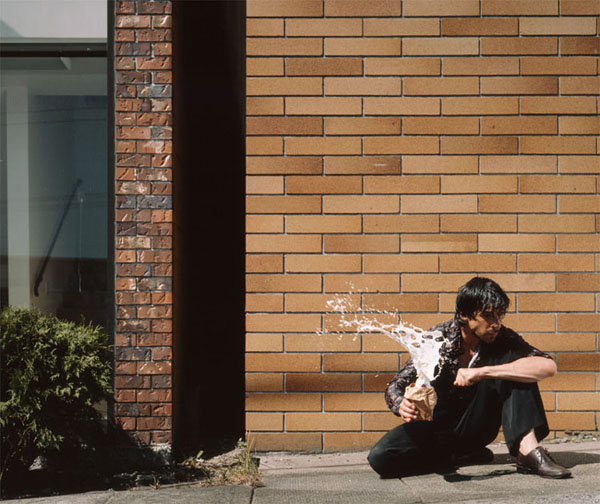
Milk 1984
Transparency in lightbox 1870 x 2290 mm
Collection FRAC Champagne–Ardenne, Reims
Cinematographic photograph
©
Jeff Wall
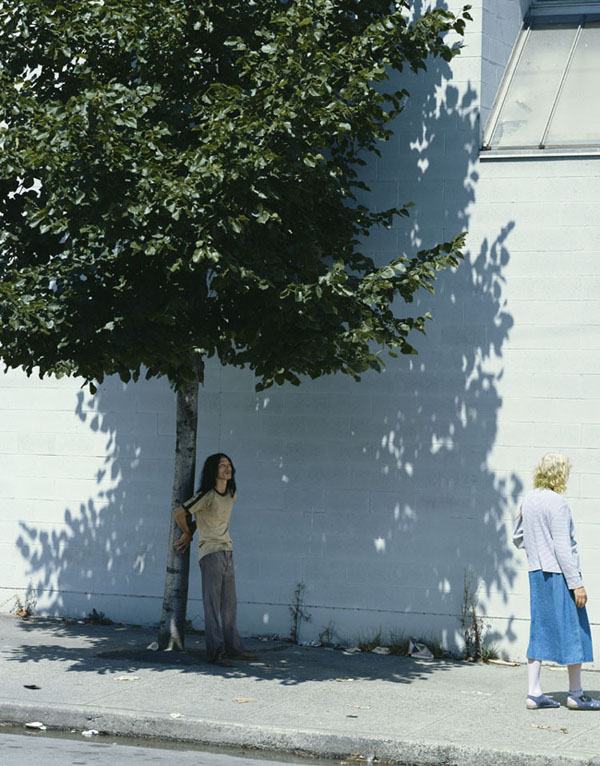
Tran Dúc Ván 1988/2003
Transparency in lightbox 2900 x 2290 mm
Carnegie Museum of Art, Pittsburgh; A.W. Mellon Acquisition Endowment
Fund and Gift of Milton Fine
Cinematographic photograph
©
Jeff Wall
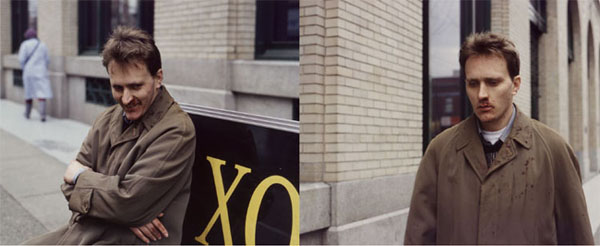
Man in Street 1995
2 transparencies in lightbox, each 540 x 660 mm
Rijksmuseum Kr?ller Müller, Otterlo
Cinematographic photograph
©
Jeff Wall
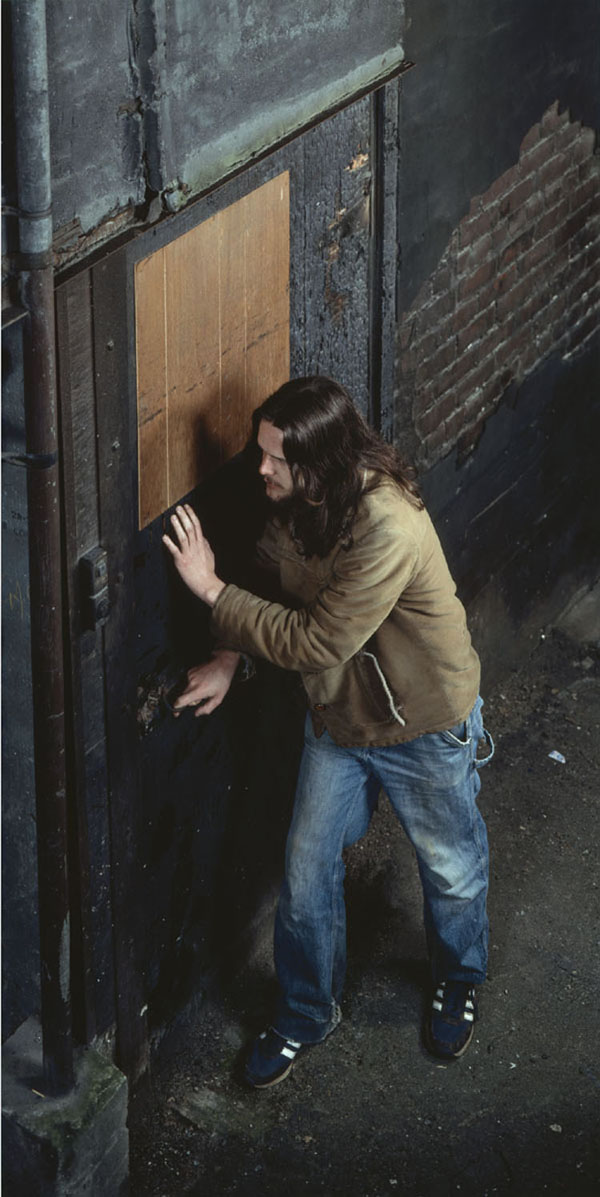
Doorpusher 1984
Transparency in lightbox 2490 x 1220 mm
Goetz Collection, Munich
Cinematographic photograph
©
Jeff Wall
The Storyteller 1986
The image of the storyteller – the woman at the bottom left hand corner
– is one that Wall has said can express the historical crisis of the
Native peoples of Canada, whose traditions of oral history have been
eroded by modern life. Though social commentary clearly features in
the work, the image remains open to interpretation: 'I like the fact
that when you really look at the world, conceptual oppositions collapse,
or become much more complex. You realise that the concrete overpasses
are neither majestic sculptures nor hideous, oppressive monoliths. They're
just spaces that we experience in different ways,' he has said.
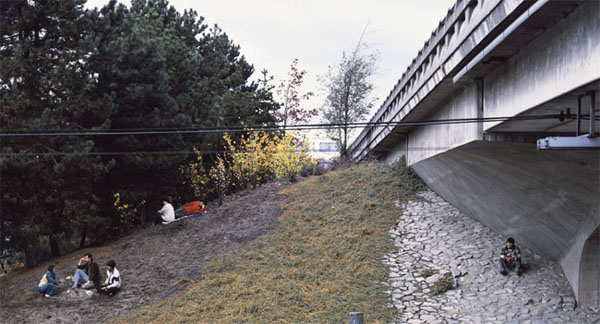
The Storyteller 1986
Transparency in lightbox 2290 x 4370 mm
Museum für Moderne Kunst, Frankfurt am Main
Cinematographic photograph
©
Jeff Wall
In this, one of his most iconic works, Wall poses a group of people
in a place that is normally overlooked. The composition evokes Manet's
Déjeuner sur l'herbe (1863), in which Manet depicts a group of Parisians
picnicking in a leafy glade, an image that, with its portrayal of a
naked woman sitting with two fully clothed men in modern dress, was
at the time deeply shocking. Like Manet, Wall takes on the role of the
observer of modern life with a radical reinterpretation of the classical
pastoral scene.
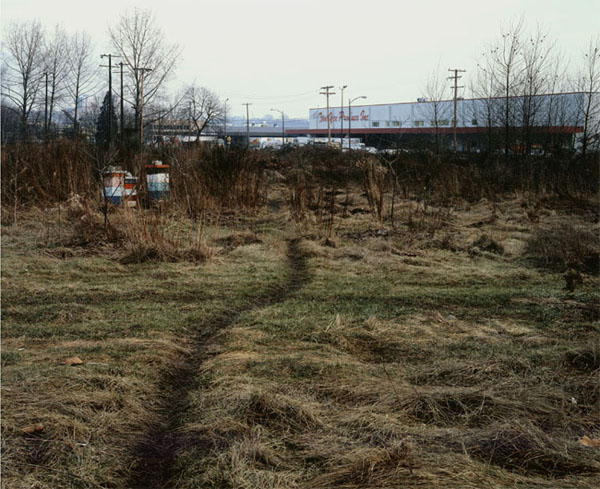
The Crooked Path 1991
Transparency in lightbox 1190 x 1490 mm
Collection Zellweger Luwa AG
Documentary photograph
©
Jeff Wall
An Octopus 1990, Some Beans 1990
These two images are identical except for the pile of beans in one of
them and the octopus in the other. The strong lighting and deep shadows
create a mood of privacy, even secrecy, accentuated by the setting,
which appears to be a cellar. Both beans and octopus seem out of place
on the worn and mismatched tables. A pair of pictures naturally invites
comparison, but here the rules for doing so are left undefined. Wall
considers these works to mark a new direction, one that allows for greater
uncertainty in the meanings of his pictures.
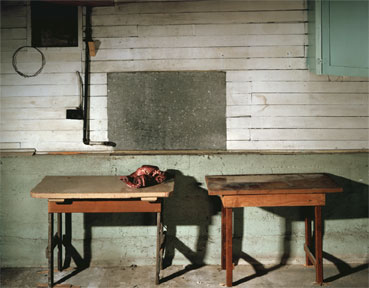
An Octopus 1990
Transparency in lightbox 1820 x 2290 mm
Collection Fondation Cartier pour l'art contemporain, Paris
Cinematographic photograph
©
Jeff Wall
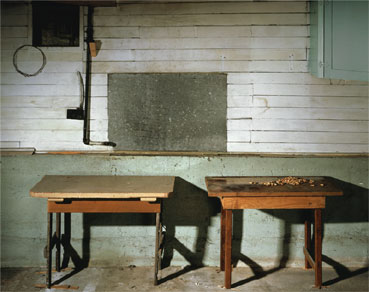
Some Beans 1990
Transparency in lightbox 1820 x 2290 mm
Goetz Collection, Munich
Cinematographic photograph
©
Jeff Wall
Diagonal Composition
The works entitled Diagonal Composition continue Wall's exploration
of the still-life genre, but in this case draw inspiration from early
twentieth-century art, particularly the abstract images of artists such
as El Lissitzky, Theo van Doesburg, and Alexander Rodchenko, whose paintings
typically comprised grids of horizontal, vertical and diagonal lines.
Documentary-style photographs of old, neglected spaces and cleaning areas are an ongoing theme in Wall's work. These discovered scenes focus attention on the ordinary and overlooked, or as Wall puts it, on 'the unattributed, anonymous poetry of the world'. At a formal level they echo the interlocking lines and bands of colour employed by the early pioneers of abstract art, but they also invite a social reading. Capturing the long passage of time that has scarred and degraded these surfaces, they evoke traces of lives lived by unknown inhabitants.
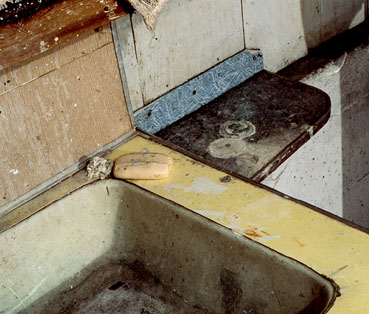
Diagonal Composition 1993
Transparency in lightbox 400 x 460 mm
Purchased from Marian Goodman Gallery, New York (General Funds) 2003
Documentary photograph
©
Jeff Wall
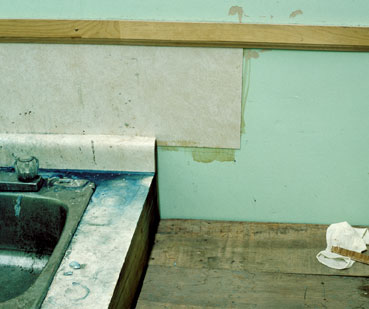
Diagonal Composition No. 2 1998
Transparency in lightbox 525 x 640 mm
Collection of the artist. Courtesy Marian Goodman Gallery, New York
Documentary photograph
©
Jeff Wall
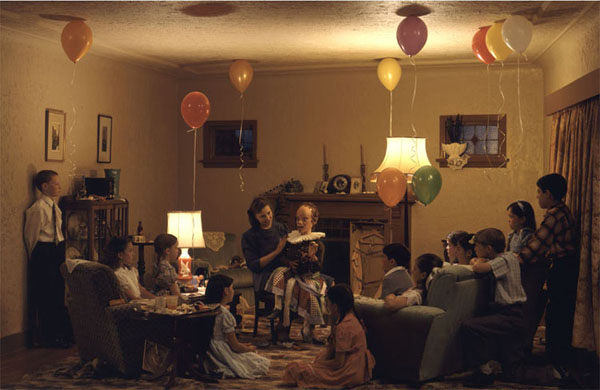
A ventriloquist at a birthday party in October 1947 1990
Transparency in lightbox 2290 x 3520 mm
Collection of the artist. Courtesy Marian Goodman Gallery, New York
Cinematographic photograph
©
Jeff Wall
Odradek, Tàboritskà 8, Prague, 18 July 1994 1994
This work draws on Franz Kafka's short story The Cares of a Family Man
(1919), about a creature called Odradek, part wooden object, part living
being, who lurks in the garrets, stairways, and lobbies of buildings,
unknown to passers-by. Like Odradek, the invisible and the hidden are
significant themes in Wall's work, from abandoned and neglected places,
to socially and politically invisible people.
The atmosphere of this photograph seems to oscillate between the foreboding of film noir and the familiarity of the everyday, the result perhaps of Wall's deliberate blending of documentary-style photography with aspects of cinematography. 'I can't draw a sharp distinction between the prosaic and the spectral, between the factual and the fantastic, and by extension between the documentary and the imaginary,' he has commented.
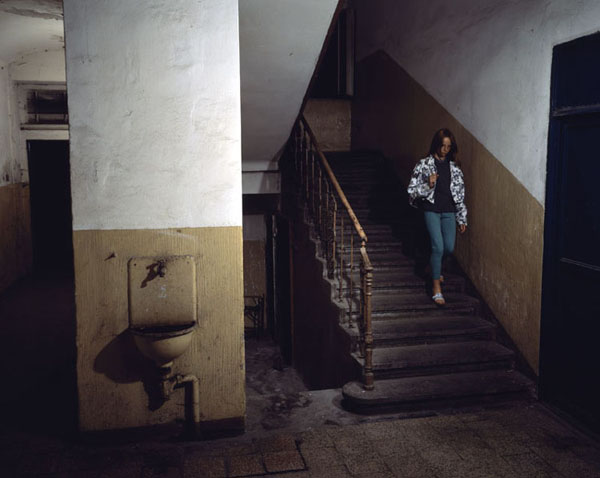
Odradek, Táboritská 8, Prague, 18 July 1994 1994
Transparency in lightbox 2290 x 2890 mm
Museum für Moderne Kunst, Frankfurt am Main. Acquired with funds of
the Stadt Frankfurt am Main, the Hessischen Kulturstiftung and a donation
by Dr. Karl-Heinz Heuer, Frankfurt am Main
Cinematographic photograph
©
Jeff Wall
After 'Invisible Man' by Ralph Ellison, the Prologue
1999-2000
Ralph Ellison's 1952 novel Invisible Man centres on a black man who,
during a street riot, falls into a forgotten room in the cellar of a
large apartment building in New York and decides to stay there, living
hidden away. The novel begins with a description of the protagonist's
subterranean home, emphasising the ceiling covered with 1,369 illegally
connected light bulbs. There is a parallel between the place of light
in the novel and Wall's own photographic practice. Ellison's character
declares: 'Without light I am not only invisible, but formless as well.'
Wall's use of a light source behind his pictures is a way of bringing
his own 'invisible' subjects to the fore, so giving form to the overlooked
in society.
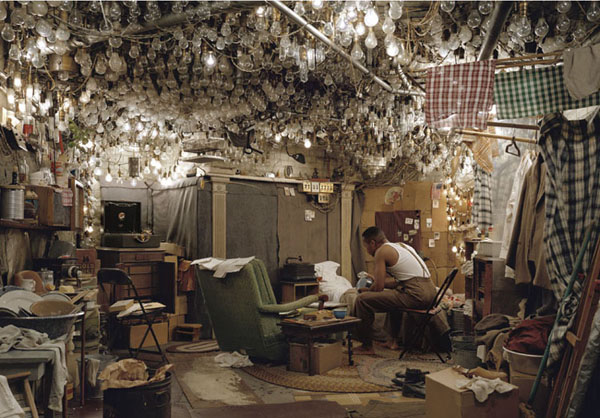
After 'Invisible Man' by Ralph Ellison, the Prologue 1999–2000
Transparency in lightbox 1740 x 2505 mm
Emanuel Hoffmann Foundation, on permanent loan to the ?ffentliche Kunstsammlung
Basel
Cinematographic photograph
©
Jeff Wall
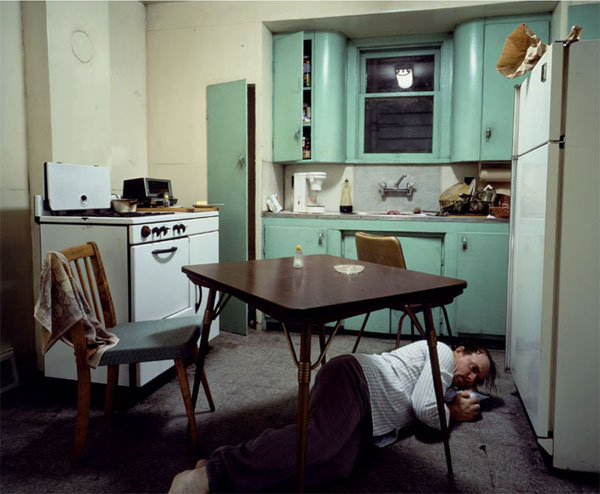
Insomnia 1994
Transparency in lightbox 1722 x 2135 mm
Hamburger Kunsthalle, Hamburg
Cinematographic photograph
©
Jeff Wall
A Sudden Gust of Wind (after Hokusai) 1993
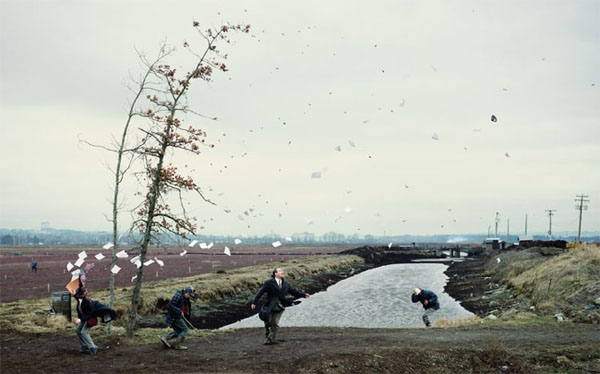
A Sudden Gust of Wind (after Hokusai) 1993
Transparency in lightbox 2290 x 3770 mm
Tate. Purchased with assistance from the Patrons of New Art through
the Tate Gallery Foundation and from the National Art Collections Fund
1995
Cinematographic photograph
©
Jeff Wall
This work is one of Wall's earliest digital montages. It refers directly
to a woodblock print by Japanese artist Katsushika Hokusai. Wall transposes
the nineteenth-century Japanese scene to a contemporary cranberry farm
near Vancouver. Amateur actors play the odd assortment of rural and
city characters, surprised by the forces of nature. It required over
100 photographs, taken over the course of more than a year, to achieve
a seamless montage that gives the illusion of capturing a real moment
in time.
Restoration
1993
This photograph shows actual conservators apparently in the process
of working on the restoration of a panoramic painting in Lucerne, Switzerland.
The title also evokes Wall’s own complex relationship with his artistic
past.
Although Wall used a 360° panorama camera, he chose to capture only 180°, or half the panorama, digitally collaging overlapping exposures. This idea was important to Wall. 'The exclusion of the space behind the camera is measured in a way that no other picture I've made is so closely measured... And of course there's a woman looking into the space... into part of the picture you can't see, to make a little accent to that notion that there's a space outside.'

Restoration 1993
Transparency in lightbox 1190 x 4895 mm
Museum of art, Lucerne
Cinematographic photograph
©
Jeff Wall
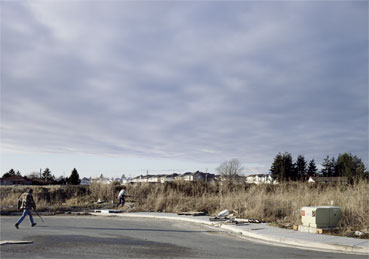
A Hunting Scene 1994
Transparency in lightbox 1670 x 2370 mm
Kunstmuseum Wolfsburg
Cinematographic photograph
©
Jeff Wall
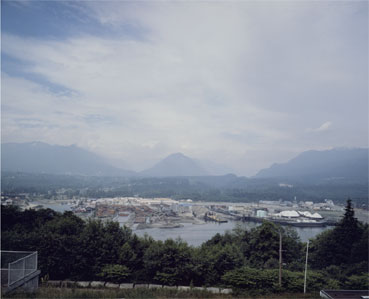
Coastal Motifs 1989
Transparency in lightbox 1190 x 1470 mm
Courtesy Marian Goodman Gallery, New York
Documentary photograph
©
Jeff Wall
Dead Troops Talk (a vision after an ambush of a Red
Army patrol, near Moqor, Afghanistan, winter 1986) 1992
In Dead Troops Talk, Wall merges conventions from war and horror movies
with those of the history painting of previous eras to create an elaborate,
grotesque fiction. The picture presents a hallucinatory scene in which
soldiers who have just been killed on the battlefield are re-animated,
engaging with each other in what the artist describes as a 'dialogue
of the dead'. As the title indicates, the troops are a Soviet patrol
ambushed in Afghanistan during the war and occupation of the 1980s.
Each figure or group seems to respond differently to the experience
of death and reanimation. The three soldiers clowning with their own
wounds provide a note of macabre levity. Wall has suggested that their
black humour is as plausible a reaction to their circumstances as the
more serious or distressed responses of their comrades. As carefully
constructed as a film or epic painting, the work was shot in a large
temporary studio, involving performers and costume, special effects
and make-up professionals. The figures were photographed separately
or in small groups and the final image was assembled as a digital montage.
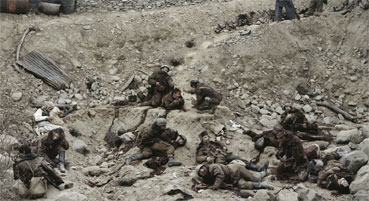
Dead Troops Talk (A vision after an ambush of a Red Army patrol, near
Moqor, Afghanistan, winter 1986) 1992
Transparency in lightbox 2290 x 4170 mm
Mr. David Pincus
Cinematographic photograph
©
Jeff Wall
Clipped Branches, East Cordova St., Vancouver
1999
Unlike his complex, staged works, Clipped Branches is a documentary
photograph. The image appears like a close-up from a film, or a detail
borrowed from a larger scene. The effect is to extract the subject from
its surroundings, so that the work also becomes a formal exploration
of vertical and diagonal lines. This is enhanced by the camera angle:
in contrast to the frontal approach generally favoured in the larger
compositions, Wall's still life and documentary photographs employ more
dynamic angles and techniques.
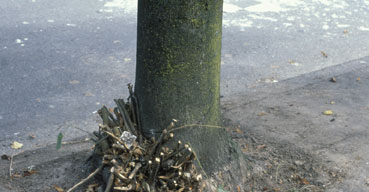
Clipped Branches, East Cordova St., Vancouver 1999
Transparency in lightbox 720 x 890 mm
Collection of the artist. Courtesy Marian Goodman Gallery, New York
Documentary photograph
©
Jeff Wall
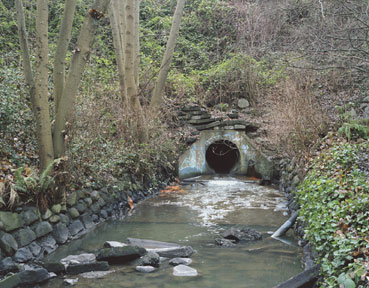
Still Creek, Vancouver, winter 2003 2003
Transparency in lightbox 2025 x 2594 mm
Collection of the artist
Documentary photograph
©
Jeff Wall
The Flooded Grave 1998-2000
Wall described the 'event' of this work as 'a moment in a cemetery.
The viewer might imagine a walk on a rainy day. He or she stops before
a flooded hole and gazes into it and for some reason imagines the ocean
bottom. We see the instant of that fantasy, and in another instant it
will be gone.' The Flooded Grave was completed over a two-year period,
and photographed at two different cemeteries in Vancouver as well as
on a set in the artist's studio. It was constructed as a digital montage
from around 75 different images.

The Flooded Grave 1998–2000
Transparency in lightbox 2285 x 2820 mm
Friedrich Christian Flick Collection
Cinematographic photograph
©
Jeff Wall
Fieldwork takes Wall's notion of 'near documentary' a step closer to
documentary photography proper. He arranged to photograph this archaeological
dig as it took place at a site near Vancouver. The American anthropologist
and his colleague weren't acting; instead, Wall photographed them daily
as they went about their work over a period of three or four weeks,
believing that they would become accustomed to his presence and ignore
the camera. As the title indicates, the anthropologist is accompanied
and observed by a member of the native tribe whose long-abandoned dwelling
is being excavated.
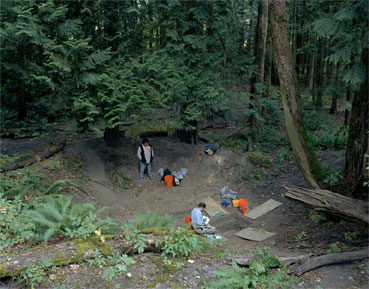
Fieldwork. Excavation of the floor of a dwelling in a former Stlo nation
village, Greenwood Island, Hope, B. C., August, 2003. Anthony Graesch,
Dept. of Anthropology, University of California at Los Angeles, working
with Riley Lewis of the Stlo band 2003
Transparency in lightbox 2195 x 2835 mm
Collection of the artist. Courtesy Marian Goodman Gallery, New York
Cinematographic photograph
©
Jeff Wall
Overpass 2001
Four people carrying luggage and parcels walk away from the viewer.
With their backs to us, the figures are anonymous; they might betravellers
visiting the city, or nomads moving through it. A subtle palette of
cool greys and blues unites the whole, from the clothes and baggage
to the surprising forms of a suddenly stormy sky. As the road stretches
into the far distance, the picture evokes a mood of pilgrimage, both
physical and emotional, or perhaps of exile. Overpass continues the
thread of 'street pictures' Wall initiated 25 years earlier, but in
a more muted key.
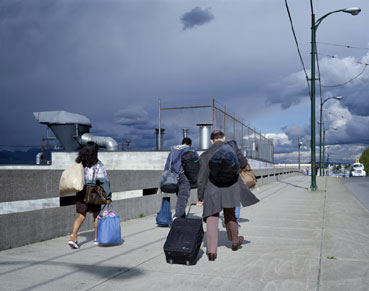
Overpass 2001
Transparency in lightbox 2140 x 2735 mm
Colecci&oactue;n de Fotografía Contemporánea de Telefónica
Cinematographic photograph
©
Jeff Wall
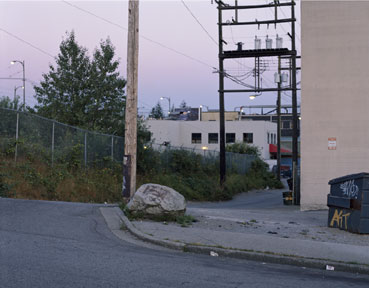
Dawn 2001
Transparency in lightbox 2300 x 2930 mm
Collection Zellweger Luwa AG
Documentary photograph
©
Jeff Wall
Concrete ball 2002
Based on a found scene, the quietness of Concrete ball reveals Wall's
attention to pictorial composition. The concern here is not torepresent
an event, but rather to depict a generic urban landscape, without specific
qualities and devoid of any drama. The perspective is carefully calculated
and the central element responds to the curve of the road. The large
scale of the work, proportioned to the human body, evokes a sense of
immersion in the scene.
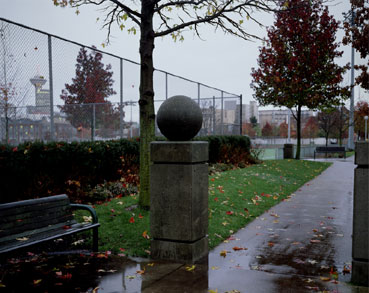
Concrete ball 2002
Transparency in lightbox 2040 x 2600 mm
Private collection, Basel
Documentary photograph
©
Jeff Wall
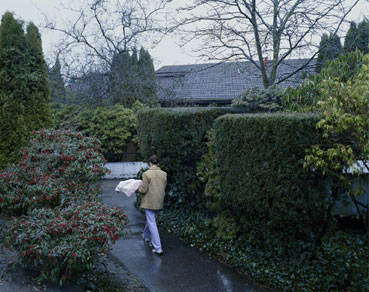
A woman with a covered tray 2003
Transparency in lightbox 1640 x 2086 mm
Panos and Sandra Marinopoulos
Cinematographic photograph
©
Jeff Wall
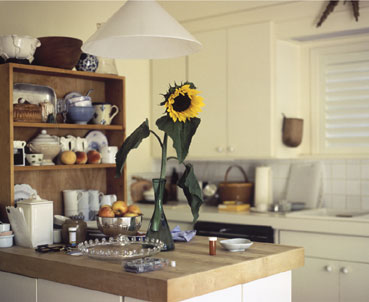
A Sunflower 1995
Transparency in lightbox 740 x 900 mm
Private collection. Courtesy Martin Schwander A&E Advisory Services,
Basel
Documentary photograph
©
Jeff Wall
Tattoos and Shadows 2000
Like
The Storyteller, Tattoos and Shadows uses posed figures to create a
visual link with a great painting of the past, Manet’s Déjeuner sur
l’herbe. But, unlike The Storyteller, a sense of social critique is
less evident in this serene work. The poses of the three figures do
not suggest a narrative; indeed, their lack of communication is striking.
Instead, as his title suggests, Wall seems to be focusing on the visual
possibilities of the scene: the patterns on tattooed arms; the stripes
created by the sun shining through the fence; and the dappling of shadow
on grass.
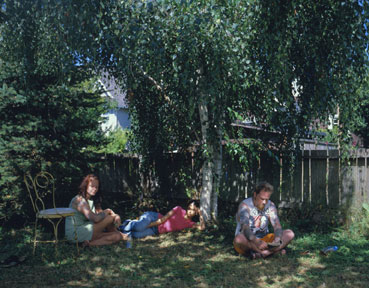
Tattoos and Shadows 2000
Transparency in lightbox 1955 x 2550 mm
Courtesy the artist
Cinematographic photograph
©
Jeff Wall
Morning Cleaning, Mies van der Rohe Foundation, Barcelona
1999
The subject of Morning Cleaning is an iconic example of modernist architecture,
Ludwig Mies van der Rohe's pavilion for the International Exhibition
of 1929, held in Barcelona. The pavilion was reconstructed in the 1980s
and is now permanently open to the public. Wall was interested in the
labour required to maintain the brilliance and transparency of the building,
with its signature glass walls and marble surfaces. We see the pavilion's
cleaner at work early in the morning before the building opens – another
example of the artist's interest in activities which are normally unseen
or overlooked.
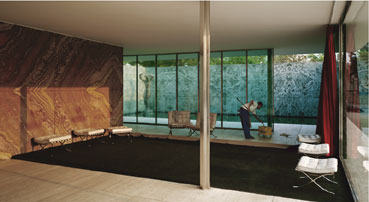
Morning Cleaning, Mies van der Rohe Foundation, Barcelona 1999
Transparency in lightbox 1807 x 3510 mm
Collection of the artist, on permanent loan to the Museum f&uulm;r
Moderne Kunst, Frankfurt am Main
Cinematographic photograph
©
Jeff Wall
A View From an Apartment 2004-5
This is Wall's most recent work. It was photographed between May 2004
and March 2005 in an apartment specially rented for the purpose. Wall
says he wanted to make a picture of an interior that included a view,
something he had not done before. He asked one of the women in the picture
to furnish the apartment and to live in it as if it were her own. Shooting
occurred at various points during this time and the resulting photographs
were then digitally combined. With A view from an apartment Wall achieves
a remarkable synthesis of a number of his preoccupations: a commonplace
interior opens onto an urban panorama; documentary material is treated
with cinematographic dynamism; the everyday is heightened through composition
and the effects of light; and a narrative is suggested but left incomplete.
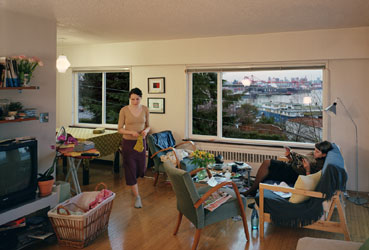
A view from an apartment 2004–2005
Transparency in lightbox 1670 x 2440 mm
Collection of the artist. Courtesy Marian Goodman Gallery, New York
Cinematographic photograph
©
Jeff Wall
